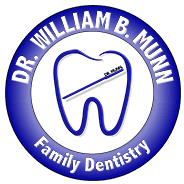Root canals are commonly misunderstood. Though you may assume a root canal is a painful, unpleasant experience, the procedure can actually alleviate the agonizing pain and discomfort of an infected or damaged tooth. In some cases, a root canal can also save you from extensive, expensive dental work. Should you forego a root canal, you could end up needing additional treatments and procedures to extract and replace the deteriorating tooth.

When performed by our experienced, gentle dentist, Dr. William Munn, your root canal will be over before you even know it. You will be left with a completely rehabilitated tooth that looks and functions normally, with no pain.
When Is a Root Canal Necessary?
Root canals are performed to save teeth that are badly decayed or damaged.
A root canal may be needed if microorganisms get inside one of your teeth (via a bad crack, area of decay or exposed tooth root) and cause infection or inflammation. Once the infection or inflammation has reached the soft inner tissue of the tooth, located in the tooth’s root canals, significant pain and discomfort can occur. Left untreated, the tooth could eventually develop an abscess and need to be removed and replaced.
During a root canal, Dr. Munn accesses the inside of the tooth to remove infected or inflamed tissue and disinfect the tooth’s roots. Then, the tooth is sealed off to prevent additional damage or decay.
Symptoms that suggest inflammation or infection inside a tooth include the following:
- Toothache, especially when biting or chewing
- A pimple-like bump on the gums
- Gum pain, tenderness or swelling
- Discoloration in the gums
- A visible abscess
- Sensitivity to hot or cold foods or beverages
Treatment Details

There are several steps to a root canal. Dr. Munn uses numbing medications and techniques that virtually eliminate pain during the procedure. Your comfort is his priority.
First, the dentist will isolate the affected tooth and create an opening in the chewing surface of the tooth. Through this opening, he can access the tooth’s roots containing the inflamed or infected tissue (this soft tissue is called “pulp”). Dr. Munn will remove the diseased pulp, disinfect the tooth’s roots and shape them. Once they are completely clean, he will fill the space using a material called gutta-percha. This seals off the roots.
To complete the root canal, our dentist will place a crown over the tooth. The dental crown covers the opening and protects the tooth from further damage or decay. With the crown in place, the tooth should be fully functional.
Caring for a Tooth after a Root Canal
After your root canal, the treated tooth may feel sensitive or tender. Avoid biting or chewing hard foods and stick to soft foods until the discomfort subsides.
Practice good at-home oral hygiene. Brush your teeth twice a day and floss once a day. Attend all follow-up appointments with our team and after that, visit us at least twice a year for dental exams and cleanings.
Learn More about Root Canal Therapy
For additional information about root canal therapy, please request an appointment with Dr. William Munn. Call or email our practice to schedule your visit today.



